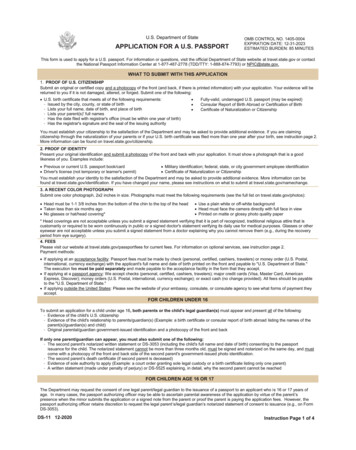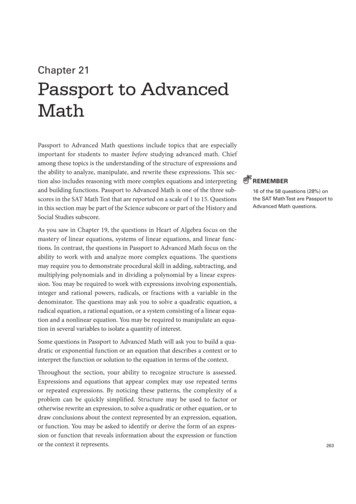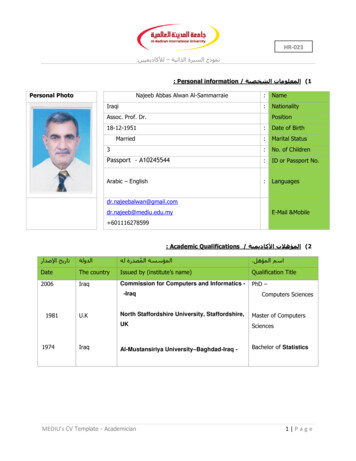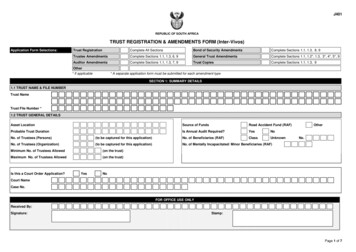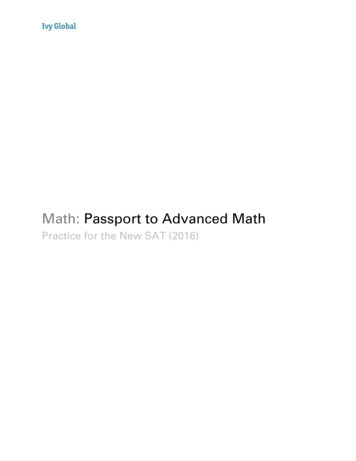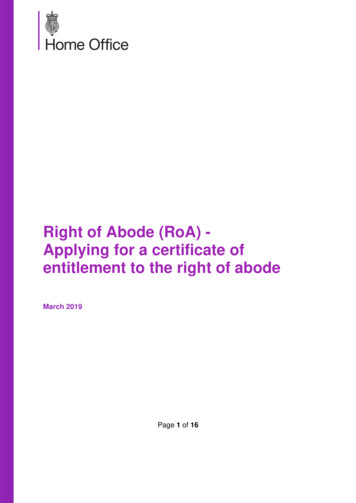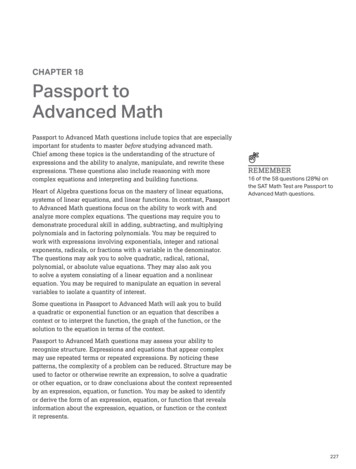
Transcription
CHAPTER 18Passport toAdvanced MathPassport to Advanced Math questions include topics that are especiallyimportant for students to master before studying advanced math.Chief among these topics is the understanding of the structure ofexpressions and the ability to analyze, manipulate, and rewrite theseexpressions. These questions also include reasoning with morecomplex equations and interpreting and building functions.Heart of Algebra questions focus on the mastery of linear equations,systems of linear equations, and linear functions. In contrast, Passportto Advanced Math questions focus on the ability to work with andanalyze more complex equations. The questions may require you todemonstrate procedural skill in adding, subtracting, and multiplyingpolynomials and in factoring polynomials. You may be required towork with expressions involving exponentials, integer and rationalexponents, radicals, or fractions with a variable in the denominator.The questions may ask you to solve quadratic, radical, rational,polynomial, or absolute value equations. They may also ask youto solve a system consisting of a linear equation and a nonlinearequation. You may be required to manipulate an equation in severalvariables to isolate a quantity of interest.REMEMBER16 of the 58 questions (28%) onthe SAT Math Test are Passport toAdvanced Math questions.Some questions in Passport to Advanced Math will ask you to builda quadratic or exponential function or an equation that describes acontext or to interpret the function, the graph of the function, or thesolution to the equation in terms of the context.Passport to Advanced Math questions may assess your ability torecognize structure. Expressions and equations that appear complexmay use repeated terms or repeated expressions. By noticing thesepatterns, the complexity of a problem can be reduced. Structure may beused to factor or otherwise rewrite an expression, to solve a quadraticor other equation, or to draw conclusions about the context representedby an expression, equation, or function. You may be asked to identifyor derive the form of an expression, equation, or function that revealsinformation about the expression, equation, or function or the contextit represents.227
PART 3 MathPassport to Advanced Math questions also assess your understandingof functions and their graphs. A question may require you todemonstrate your understanding of function notation, includinginterpreting an expression where the argument of a function is anexpression rather than a variable. The questions may assess yourunderstanding of how the algebraic properties of a function relate tothe geometric characteristics of its graph.Passport to Advanced Math questions include both multiple-choicequestions and student-produced response questions. Some of thesequestions are in the no-calculator portion, where the use of a calculatoris not permitted, and others are in the calculator portion, where the useof a calculator is permitted. When you can use a calculator, you mustdecide whether using your calculator is an effective strategy for thatparticular question.Passport to Advanced Math is one of the three SAT Math Testsubscores, reported on a scale of 1 to 15.Let’s consider the content and skills assessed by Passport to AdvancedMath questions.Operations with Polynomials andRewriting ExpressionsQuestions on the SAT Math Test may assess your ability to add,subtract, and multiply polynomials.Example 1( x 2 bx 2)(x 3) x 3 6x 2 7x 6In the equation above, b is a constant. If the equation is true for all values of x,what is the value of b?A) 2B) 3C) 7REMEMBERPassport to Advanced Mathquestions build on the knowledgeand skills tested on Heart of Algebraquestions. Develop proficiency withHeart of Algebra questions beforetackling Passport to Advanced Mathquestions.228D) 9To find the value of b, use the distributive property to expand the left-handside of the equation and then collect like terms so that the left-hand sideis in the same form as the right-hand side.(x 2 bx 2)(x 3) (x 3 bx 2 2x ) (3x 2 3bx 6) x 3 (3 b ) x 2 (3b 2) x 6
Chapter 18 Passport to Advanced MathSince the two polynomials are equal for all values of x, the coefficientof matching powers of x should be the same. Therefore, comparingthe coefficients of x 3 (3 b ) x 2 (3b 2) x 6 and x 3 6x 2 7x 6reveals that 3 b 6 and 3b 2 7. Solving either of these equationsgives b 3, which is choice B.Questions may also ask you to use structure to rewrite expressions.The expression may be of a particular type, such as a difference ofsquares, or it may require insightful analysis.Example 2Which of the following is equivalent to 16s4 4t 2?A) 4(s 2 t )(4s 2 t )B)C) 4(2s 2 t )(2s 2 t )D) (8s 2 2t )(8s 2 2t )A closer look reveals that the given equation follows the difference oftwo perfect squares pattern, x 2 y 2, which factors as (x y ) (x y ).The expression 16s 4 4t 2 is also the difference of two squares:2216s 4 4t 2 (4s 2) (2t ) . Therefore, it can be factored as22(4s 2) (2t ) (4s 2 2t ) (4s 2 2t ). This expression can be rewritten as(4s 2 2t ) (4s 2 2t ) 2(2s 2 t ) (2) (2s 2 t ) 4(2s 2 t ) (2s 2 t ), which ischoice C.PRACTICE ATsatpractice.orgPassport to Advanced Mathquestions require a high comfortlevel working with quadraticequations and expressions,including multiplying polynomialsand factoring. Recognizing classicquadratic patterns such as x 2 y 2 (x y )(x y ) can also improve yourspeed and accuracy.Alternatively, a 4 could be factored out of the given equation:4(4s 4 t 2). The expression inside the parentheses is a difference of twosquares. Therefore, it can be further factored as 4(2s 2 t )(2s 2 t ).Example 3Which expression is equivalent to xy 2 2xy 2 3xy?A) 2xy 2 3xyB) 3xy 2 3xyC) 6xy 4D) 6xy 5There are three terms in the expression, the first two of which arelike terms. The like terms can be added together by adding theircoefficients: xy 2 2xy 2 3xy (xy 2 2xy 2) 3xy, which is equivalentto 3xy 2 3xy. Therefore choice B is correct.229
PART 3 MathQuadratic Functions and EquationsQuestions in Passport to Advanced Math may require you to build aquadratic function or an equation to represent a context.Example 4PRACTICE ATsatpractice.orgExample 4 requires carefultranslation of a word problem intoan algebraic equation. It pays to bedeliberate and methodical whentranslating word problems intoequations on the SAT.A car is traveling at x feet per second. The driver sees a red light ahead, andafter 1.5 seconds reaction time, the driver applies the brake. After the brake isx seconds to stop, during which time the average speedapplied, the car takes24x feet per second. If the car travels 165 feet from the time theof the car is2driver saw the red light to the time it comes to a complete stop, which of thefollowing equations can be used to find the value of x?A) x 2 48x 3,960 0B) x 2 48x 7,920 0C) x 2 72x 3,960 0D) x 2 72x 7,920 0During the 1.5-second reaction time, the car is still traveling at x feetper second, so it travels a total of 1.5x feet. The average speed ofxxthe car during the -second braking interval is feet per second,242xxx2so over this interval, the car travels feet. Since the2 2448total distance the car travels from the time the driver saw the redlight to the time it comes to a complete stop is 165 feet, you have thex2equation 1.5x 165. This quadratic equation can be rewritten in48standard form by subtracting 165 from each side and then multiplyingeach side by 48, giving x 2 72x 7,920 0, which is choice D.( )( )REMEMBERThe SAT Math Test may ask youto solve a quadratic equation. Beprepared to use the appropriatemethod. Practice using the variousmethods (below) until you arecomfortable with all of them.1. Factoring2. Completing the square3. Using the quadratic formula4. Using a calculator5. Using structure230Some questions on the SAT Math Test will ask you to solve a quadraticequation. You must determine the appropriate procedure: factoring,completing the square, using the quadratic formula, using a calculator(if permitted), or using structure. You should also know the followingfacts in addition to the formulas in the directions:§ §The sum of the solutions of x 2 bx c 0 is b.§ §The product of the solutions of x 2 bx c 0 is c.Each of the facts can be seen from the factored form of aquadratic. If r and s are the solutions of x 2 bx c 0, thenx 2 bx c (x r )(x s ). Thus, b (r s ) and c ( r )( s ) rs.Note: To use either of these facts, the coefficient of x 2 must be equal to 1.
Chapter 18 Passport to Advanced MathExample 5What are the solutions to the equation x 2 3 x? 1 11 A) 2 1 13B) 21 11C) 21 13D) 2The equation can be solved by using the quadratic formula or bycompleting the square. Let’s use the quadratic formula. First, subtractx from each side of x 2 3 x to put the equation in standard form:x 2 x 3 0. The quadratic formulastates the solutions x of the2 b b 4ac equation ax 2 bx c 0 are . For the equation2ax 2 x 3 0, you have a 1, b 1, and c 3. Substituting these ( 1) ( 1) 4(1)( 3) values into the quadratic formula gives x 21 1 ( 12) 1 13 , which is choice D.222(1)PRACTICE ATsatpractice.orgThe quadratic formula statesthat the solutions x of the2 bx c 0 areequation ax2 b b 4ac x .2aExample 6If x 0 and 2x 2 3x 2 0, what is the value of x?REMEMBERThe left-hand side of the equation can be factored:2x 2 3x 2 (2x 1)(x 2) 0. Therefore, either 2x 1 0, which1gives x , or x 2 0, which gives x 2. Since x 0, the value of21x is .2Example 7Pay close attention to all of thedetails in the question. In Example 6,1x can equal or 2, but since the2question states that x 0, the value1of x must be .2What is the sum of the solutions of (2x 1)2 (x 2)2?If a and b are real numbers and a 2 b 2, then either a b or a b.Since (2x 1)2 (x 2)2, either 2x 1 x 2 or 2x 1 (x 2). In the1first case, x 3, and in the second case, 3x 1, or x . Therefore,38122the sum of the solutions x of (2x 1) (x 2) is 3 .33( )231
PART 3 MathExponential Functions, Equations,and Expressions and RadicalsWe examined exponential functions in Example 7 of Chapter 17.Some Passport to Advanced Math questions ask you to build a functionthat models a given context. As discussed in Chapter 17, exponentialfunctions model situations in which a quantity is multiplied by aconstant factor for each time period. An exponential function can beincreasing with time, in which case it models exponential growth, or itcan be decreasing with time, in which case it models exponential decay.Example 8A researcher estimates that the population of a city is increasing at an annualrate of 0.6%. If the current population of the city is 80,000, which of thefollowing expressions appropriately models the population of the city t yearsfrom now according to the researcher’s estimate?A) 80,000(1 0.006)tB) 80,000(1 0.006t)C) 80,000 1.006tD) 80,000(0.006t)PRACTICE ATsatpractice.orgA quantity that grows or decays bya fixed percent at regular intervals issaid to possess exponential growthor decay, respectively.Exponential growth is representedby the function y a(1 r)t, whileexponential decay is representedby the function y a(1 r)t, where yis the new population, a is the initialpopulation, r is the rate of growth ordecay, and t is the number of timeintervals that have elapsed.According to the researcher’s estimate, the population isincreasing by 0.6% each year. Since 0.6% is equal to 0.006,after the first year, the population is 80,000 0.006(80,000) 80,000(1 0.006). After the second year, the population is80,000(1 0.006) 0.006(80,000)(1 0.006) 80,000(1 0.006) 2.Similarly, after t years, the population will be 80,000(1 0.006) taccording to the researcher’s estimate. This is choice A.A well-known example of exponential decay is the decay of a radioactiveisotope. One example is iodine-131, a radioactive isotope used insome medical treatments, which decays to xenon-131. The half-life ofiodine-131 is 8.02 days; that is, after 8.02 days, half of the iodine-131 ina sample will have decayed to xenon-131. Suppose a sample with a massof A milligrams of iodine-131 decays for d days. Every 8.02 days, the1quantity of iodine-131 is multiplied by , or 2 1. In d days, a total2ddifferent 8.02-day periods will have passed, and so theof 8.02doriginal quantity will have been multiplied by 2 1 a total of times.8.02Therefore, the mass, in milligrams, of iodine-131 remaining in thedsample will be A(2 1) 8.02 A( 2 d 8.02 ) .1In the preceding discussion, we used the identity 2 1. Questions2on the SAT Math Test may require you to apply this and other laws ofexponents and the relationship between powers and radicals.232
Chapter 18 Passport to Advanced MathSome Passport to Advanced Math questions ask you to use propertiesof exponents to rewrite expressions.Example 9( )1 n?Which of the following is equivalent to xnA) x 2B) xC) xD) xn 21n 21n 211 1 x 2 ,The expression x is equal to x 2 . Thus, xn1 nn 1and ( x 2 ) x 2 . Choice B is the correct answer. xAn SAT Math Test question may also ask you to solve a radicalequation. In solving radical equations, you may square both sides ofan equation. Since squaring both sides of an equation may result inan extraneous solution, you may end up with a root to the simplifiedequation that is not a root to the original equation. Thus, when solvinga radical equation, you should check any solution you get in the originalequation.( )Example 10PRACTICE ATsatpractice.orgPractice your exponent rules.1Know, for instance, that x x 2 and1 1 x 2 . that xx 12 x 44What are all possible solutions to the given equation?A) 5B) 20C) 5 and 20D) 5 and 20Squaring each side of x 12 x 44 gives2 (x 12)2 ( x 44 ) x 44x 2 24x 144 x 44x 2 25x 100 0(x 5)(x 20) 0The solutions to the quadratic equation are x 5 and x 20. However,since the first step was to square each side of the given equation,which may have introduced an extraneous solution, you need to checkx 5 and x 20 in the original equation. Substituting 5 for x gives5 12 5 44 7 49233
PART 3 MathPRACTICE ATThis is not a true statement (since 49 represents the principal squareroot, or onlythe positive square root, 7), so x 5 is not a solution tox 12 x 44 . Substituting 20 for x givessatpractice.org20 12 20 44A good strategy to use when solvingradical equations is to square bothsides of the equation. When doingso, however, be sure to check thesolutions in the original equation,as you may end up with a root thatis not a solution to the originalequation.8 64This is a true statement, so x 20 is a solution to x 12 x 44 .Therefore, the only solution to the given equation is 20, which ischoice B.Solving Rational EquationsQuestions on the SAT Math Test may assess your ability to workwith rational expressions, including fractions with a variable in thedenominator. This may include finding the solution to a rationalequation.Example 113 2 1t 1 t 3 4If t is a solution to the given equation and t 0, what is the value of t?PRACTICE ATsatpractice.orgWhen solving for a variable in anequation involving fractions, a goodfirst step is to clear the variable outof the denominators of the fractionsRemember that you can onlymultiply both sides of an equationby an expression when you know theexpression cannot be equal to 0.If both sides of the equation are multiplied by the lowest commondenominator, which is 4(t 1)(t 3), the resulting equation will not haveany fractions, and the variable will no longer be in the denominator.This gives 12(t 3) 8(t 1) (t 1)(t 3). This can be rewritten as12t 36 (8t 8) (t 2 4t 3), or 12t 36 t 2 12t 11, which simplifiesto 0 t 2 25. This equation factors to 0 (t 5)(t 5). Therefore, thesolutions to the equation are t 5 and t 5. Since t 0, the value of t is 5.Systems of EquationsQuestions on the SAT Math Test may ask you to solve a system ofequations in two variables in which one equation is linear and theother equation is quadratic or another nonlinear equation.Example 123x y 32(x 1) 4(x 1) 6 yPRACTICE ATsatpractice.orgThe first step used to solve thisexample is substitution, an approachyou may use on Heart of Algebraquestions. The other key wasnoticing that (x 1) can be treatedas a variable.234If (x, y) is a solution of the system of equations above and y 0, what is thevalue of y?One method for solving systems of equations is substitution. If thefirst equation is solved for y, it can be substituted in the secondequation. Subtracting 3x from each side of the first equation gives youy 3 3x, which can be rewritten as y 3(x 1).Substituting 3(x 1) for y in the second equation gives you
Chapter 18 Passport to Advanced Math(x 1)2 4(x 1) 6 3(x 1). Since the factor (x 1) appears as asquared term and a linear term, the equation can be thought of as aquadratic equation in the variable (x 1), so collecting the terms andsetting the expression equal to 0 gives you (x 1)2 (x 1) 6 0.Factoring gives you ((x 1) 3)((x 1) 2) 0, or (x 2)(x 3) 0.Thus, either x 2, which gives y 3 3(2) 9; or x 3, which givesy 3 3( 3) 6. Therefore, the solutions to the system are (2, 9) and( 3, 6). Since the question states that y 0, the value of y is 6.y(–3, 6)x(2, –9)The solutions of the system are given by the intersection points ofthe two graphs. Questions on the SAT Math Test may assess this orother relationships between algebraic and graphical representationsof functions.Relationships Between Algebraic andGraphical Representations of FunctionsA function f has a graph in the xy-plane, which is the graph of theequation y f (x), or, equivalently, consists of all ordered pairs (x, f (x)).Some Passport to Advanced Math questions assess your ability torelate properties of the function f to properties of its graph, and viceversa. You may be required to apply some of the following relationships:§ Intercepts. The x-intercepts of the graph of f correspond to valuesof x such that f (x) 0, which corresponds to where the graphintersects with the x-axis; if the function f has no zeros, its graphhas no x-intercepts, and vice versa. The y-intercept of the graphof f corresponds to the value of f (0), or where the graph intersectswith the y-axis. If x 0 is not in the domain of f, the graph of f hasno y-intercept, and vice versa.§ Domain and range. The domain of f is the set of all x for whichf (x) is defined. The range of f is the set of all y such that y f (x) forsome value of x in the domain. The domain and range can be foundfrom the graph of f as the set of all x-coordinates and y-coordinates,respectively, of points on the graph.§ §Maximum and minimum values. The maximum and minimumvalues of f can be found by locating the highest and the lowestpoints on the graph, respectively. For example, suppose P is thePRACTICE ATsatpractice.orgThe domain of a function is the setof all values for which the functionis defined. The range of a function isthe set of all values that correspondto the values in the domain, giventhe relationship defined by thefunction, or the set of all outputsthat are associated with all of thepossible inputs.235
PART 3 Mathhighest point on the graph of f. Then the y-coordinate of P is themaximum value of f, and the x-coordinate of P is where f takes onits maximum value.§ Increasing and decreasing. The graph of f shows the intervalsover which the function f is increasing and decreasing.§ End behavior. The graph of f can indicate if f (x) increases ordecreases without limit as x increases or decreases without limit.§ Transformations. For a graph of a function f, a change of the formf (x) a will result in a vertical shift of a units and a change of theform f (x a) will result in a horizontal shift of a units.Note: The SAT Math Test uses the following conventions about graphsin the xy-plane unless a particular question clearly states or shows adifferent convention:§ The axes are perpendicular.§ Scales on the axes are linear scales.REMEMBERDon’t assume the size of the unitson the two axes are equal unlessthe question states they are equalor you can conclude they are equalfrom the information given.§ The size of the units on the two axes cannot be assumed to beequal unless the question states they are equal or you are givenenough information to conclude they are equal.§ The values on the horizontal axis increase as you move to the right.§ The values on the vertical axis increase as you move up.Example 13The graph of which of the following functions in the xy-plane has x-interceptsat 4 and 5?A) f (x) (x 4)(x 5)B)C) h (x) (x 4)2 5D) k (x) (x 5)2 4The x-intercepts of the graph of a function correspond to the zeros ofthe function. All the functions in the choices are defined by quadraticequations, so the answer must be a quadratic function. If a quadraticfunction has x-intercepts at 4 and 5, then the values of the functionat 4 and 5 are each 0; that is, the zeros of the function occur at x 4and at x 5. Since the function is defined by a quadratic equation andhas zeros at x 4 and x 5, it must have (x 4) and (x 5) as factors.Therefore, choice A, f (x) (x 4)(x 5), is correct.236
Chapter 18 Passport to Advanced MathThe graph in the xy-plane of each of the functions in the previousexample is a parabola. Using the defining equations, you can tell thatthe graph of g has x-intercepts at 4 and 5; the graph of h has its vertexat (4, 5); and the graph of k has its vertex at ( 5, 4).y108642–2–2–4satpractice.orgAnother way to think of Example 13is to ask yourself, “Which answerchoice represents a function thathas values of zero when x 4 andx 5?”Example 14–4PRACTICE AT24xThe function f (x) x 4 2.4x 2 is graphed in the xy-plane where y f (x), asshown above. If k is a constant such that the equation f (x) k has 4 solutions,which of the following could be the value of k?A) 1B) 0C) 1D) 2Choice C is correct. Since f (x) x 4 2.4x 2, the equation f (x) k, orx 4 2.4x 2 k, will have 4 solutions if and only if the graph of thehorizontal line with equation y k intersects the graph of f at 4 points.The graph shows that of the given choices, only for choice C, 1, doesthe graph of y 1 intersect the graph of f at 4 points.Function NotationThe SAT Math Test assesses your understanding of function notation.You must be able to evaluate a function given the rule that definesit, and if the function describes a context, you may need to interpretthe value of the function in the context. A question may ask you tointerpret a function when an expression, such as 2x or x 1, is used asthe argument instead of the variable x.Example 15If g (x) 2x 1 and f (x) g (x) 4, what is f (2)?You are given f (x) g (x) 4 and therefore f (2) g (2) 4. To determinethe value of g (2), use the function g (x) 2x 1. Thus, g (2) 2(2) 1,and therefore g (2) 5. Substituting g (2) gives f (2) 5 4, or f (2) 9.PRACTICE ATsatpractice.orgWhat may seem at first to be acomplex question could boil downto straightforward substitution.237
PART 3 MathAlternatively, since f (x) g (x) 4 and g (x) 2x 1, it follows that f (x)must equal 2x 1 4, or 2x 5. Therefore, f (2) 2(2) 5 9.Interpreting and Analyzing MoreComplex Equations in ContextEquations and functions that describe a real-life context can becomplex. Often, it’s not possible to analyze them as completely asyou can analyze a linear equation or function. You still can acquirekey information about the context by interpreting and analyzing theequation or function that describes it. Passport to Advanced Mathquestions may ask you to identify connections between the function,its graph, and the context it describes. You may be asked to use anequation describing a context to determine how a change in onequantity affects another quantity. You may also be asked to manipulatean equation to isolate a quantity of interest on one side of the equation.You may be asked to produce or identify a form of an equation thatreveals new information about the context it represents or about thegraphical representation of the equation.Example 16For a certain reservoir, the function f gives the water level f (n), to the nearestwhole percent of capacity, on the nth day of 2016. Which of the following is thebest interpretation of f (37) 70?A) The water level of the reservoir was at 37% capacity for 70 days in 2016.B) The water level of the reservoir was at 70% capacity for 37 days in 2016.C) On the 37th day of 2016, the water level of the reservoir was at 70% capacity.D) On the 70th day of 2016, the water level of the reservoir was at 37% capacity.PRACTICE ATsatpractice.orgAnother way to check your answerin Example 17 is to substitute simplenumerical values for the variablesm, v, and KE and examine the effecton KE when those values are alteredas indicated by the question. Ifthe value 1 is substituted for both1m and v, then KE is . However,1substituting for m and 2 for v2yields a value for KE of 1. Since 1 is1twice the value of , you know that2KE is doubled.238The function f gives the water level, to the nearest whole percent ofcapacity, on the nth day of 2016. It follows that f (37) 70 means that onthe 37th day of 2016, the water level of the reservoir was at 70% capacity.This statement is choice C.Example 17If an object of mass m is moving at speed v, the object’s kinetic energy (KE) is1 mv 2. If the mass of the object is halved and itsgiven by the equation KE 2speed is doubled, how does the kinetic energy change?A) The kinetic energy is halved.B) The kinetic energy is unchanged.C) The kinetic energy is doubled.D) The kinetic energy is quadrupled (multiplied by a factor of 4).
Chapter 18 Passport to Advanced MathChoice C is correct. If the mass of the object is halved, the newmmass is . If the speed of the object is doubled, its new speed is 2v.21 m1 mTherefore, the new kinetic energy is (2v)2 (4v 2) mv 2.2 22 2This is double the original kinetic energy of the object, which1was mv 2.2( )( )Example 18A gas in a container will escape through holes of microscopic size, as long asthe holes are larger than the gas molecules. This process is called effusion. If agas of molar mass M1 effuses at a rate of r1 and a gas of molar mass M2 effusesat a rate of r2, then the following relationship holds.r 1M2r2 M1 This is known as Graham’s law. Which of the following correctly expresses M2in terms of M1, r1, and r2? ()r2A) M2 M1 12 r2()r2B) M2 M1 22 r1( )rD) M M ( r )r1C) M2 M1 r2 212PRACTICE AT1 M2rewritten as M1( )( ) ( r1Mr 12Squaring each side ofr2 M1 gives r2 2)M2 2 , which can beM1M2 r 12 r 12 2 . Multiplying each side of 2 by M1 givesr 2 M1r 2 r M2 M1 , which is choice A.r 2122Example 19satpractice.orgAlways start by identifyingexactly what the question asks.In Example 18, you are being askedto isolate the variable M2. Squaringboth sides of the equation is agreat first step as it allows you toeliminate the radical sign.A store manager estimates that if a video game is sold at a price of p dollars,the store will have weekly revenue, in dollars, of r (p) 4p2 200p from thesale of the video game. Which of the following equivalent forms of r (p) shows,as constants or coefficients, the maximum possible weekly revenue and theprice that results in the maximum revenue?A) r (p) 200p 4p2B) r (p) 2(2p2 100p)C) r (p) 4(p2 50p)D) r (p) 4(p 25)2 2,500239
PART 3 MathPRACTICE ATsatpractice.orgThe fact that the coefficient of thesquared term is negative for thisfunction indicates that the graphof r in the coordinate plane is aparabola that opens downward.Thus, the maximum value ofrevenue corresponds to the vertexof the parabola.240Choice D is correct. The graph of r in the coordinate plane is a parabolathat opens downward. The maximum value of revenue correspondsto the vertex of the parabola. Since the square of any real number isalways nonnegative, the form r (p) 4(p 25)2 2,500 shows that thevertex of the parabola is (25, 2,500); that is, the maximum must occurwhere 4(p 25)2 is 0, which is p 25, and this maximum isr (25) 2,500. Thus, the maximum possible weekly revenue and theprice that results in the maximum revenue occur as constants inthe form r (p) 4(p 25)2 2,500.
Advanced Math Passport to Advanced Math questions include topics that are especially important for students to master before studying advanced math. Chief among these topics is the understanding of the structure of expressions and the ability to analyze, manipulate, and rewrite these expr

